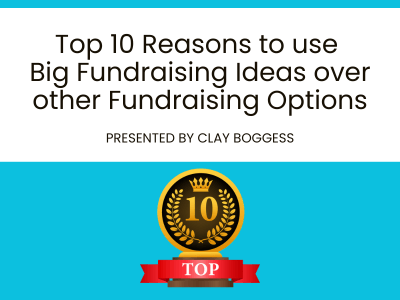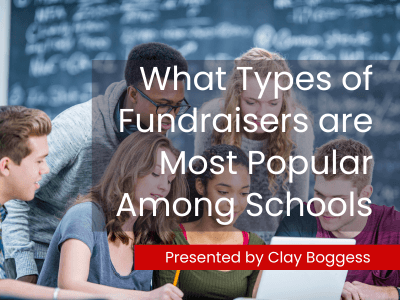
Learn which groups benefit more from traditional incentive plans.
Private schools are generally known for maximizing their sales opportunities in the fundraising industry. Student participation can sometimes reach 80 to 90% or even higher. Parents already understand they are expected to fundraise to cover tuition fees and supply costs. There are other factors to consider, but we won’t consider them for this article.
One such small catholic school approached us because they were interested in further improving their catalog sale. They were initially excited about using our Big Event Reptile Adventures Show for their incentive plan because it completely differed from anything they’d ever done. They figured that the uniqueness of this prize program would motivate their students to sell even more items. Their previous fall sale was already quite impressive. With an enrollment of 150 students, they brought in close to $30,000. And this was with a traditional prize plan.
They were excited about their plan until they realized that many students would stop after selling five items. Students only needed to sell five items out of their catalog to gain admission to the reptile show. This feature is what attracts many schools to our Big Event Prize Programs. The idea is to get more students to participate in school fundraisers by offering an exciting prize at the lowest price level in exchange for reaching an easily obtainable sales goal.
As a result, more students want to get involved. This has worked well for many schools. Depending on the type of school, big event incentive programs significantly outperform standard (traditional) incentive plans (We refer to standard or traditional prize programs as those typically offered by most fundraising companies in our industry). Here’s a small sample of schools that initially worked with us using a traditional prize program and then the following year switched to a big event incentive plan:
| School | Traditional Prizes | Big Event Incentive | $ Increase | % Increase |
|---|---|---|---|---|
| Webb Elementary | $20,000 | $43,000 | $23,000 | 115% |
| Noonan Elementary | $8,000 | $27,000 | $19,000 | 238% |
| Kostoryz Elementary | $12,000 | $31,000 | $19,000 | 158% |
| Milton Elementary | $24,000 | $42,000 | $18,000 | 75% |
| Meadowbrook Elementary | $12,000 | $27,000 | $15,000 | 125% |
Big event incentives have been proven to enhance the sales of larger public schools (500 or more students) that struggle to get their students to participate. Yet they may not work as well for our small catholic school because they already had a high level of involvement. This school was only attempting to improve sales further by increasing the number of items sold per seller.
Granted, our reptile adventures show also offered higher prizes designed to increase sales, just like traditional incentive plans. But the problem was our small catholic school was fixated on the idea that gaining admission to a live reptile show was at the lowest prize level, not the highest. And the show was going to be the centerpiece. This contradicts traditional prize programs, which require students to sell more items to win bigger prizes.
Learn 13 keys to strong school fundraising involvement.
Instead, they ended up selecting one of our traditional prize programs. And let’s face it; even if 100% of their students sold five items and stopped, their sales would have been lower than the previous year with the standard prize plan. This made us realize that some schools probably benefit more from our big event fundraising prize programs than others. This begs the question; which schools should consider a big event program? To help answer this, here are just some of the differences between the two types of prize programs:
Traditional Prize Program Features
- Students win inexpensive prizes at the lower levels.
- Bigger and better prizes require more selling.
- This may work well for schools with good participation levels that want to improve the number of items sold per seller.
The Big Event Prize Program Niche
- Sellers gain admission to one of our big events in exchange for selling a small number of items.
- Students can reach higher prize levels and win additional privileges and prizes, but getting to the big event is the most appealing feature of this type of program.
- Big event programs work exceptionally well for larger groups that need to get more students involved in their school fundraiser.
3 Reasons Schools Want Big Event Fundraising Prizes
Why Schools Choose a Big Event Incentive
Parents don’t have to sell much to get their students into a big event. This is why many schools choose our big event programs. In other words, parents understand they won’t have to work very hard to appease their students. Traditional prize programs only offer cheap prizes for selling a few items from the brochure, which is why most students only want the higher level prizes.
So why did our catholic school opt for a traditional prize program? We know they already had a large number of students participating. They were still looking to upgrade their prize program; however, if they had chosen Reptile Adventures, their concern was that too many students would have been content at the lowest prize level. Going to the reptile show is what most students want.
Which Types of Schools Excel with Big Events?
Which schools benefit the most from big event prize programs? Larger enrollment elementary schools that are struggling with lower than desired student participation. Many schools hover around 10% on the low end and consider it a significant accomplishment if they can get 25% of their students to sell. Just think of the amount of money that can be brought in if they could improve it to 50% or more.
Big schools have the most significant potential for sales gain because of the number of students that could be selling. Many have become disillusioned with traditional prize programs that force students to sell more to receive valuable prizes. As it turns out, most students who sell don’t end up trying for the higher levels.
How to Improve Schoolwide Fundraiser Participation
In conclusion, larger schools with a lower student participation rate benefit most from big event fundraising programs. And smaller schools? It depends.
Author Bio
Clay Boggess has been designing fundraising programs for schools and various nonprofit organizations throughout the US since 1999. He’s helped administrators, teachers, and outside support entities such as PTAs and PTOs raise millions of dollars. Clay is an owner and partner at Big Fundraising Ideas.



